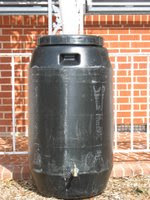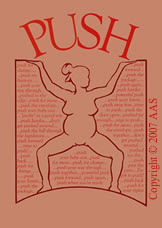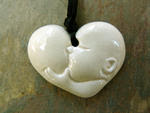Following is a story by a young Tlingit woman about how her ancestors gave birth and what she wishes to bring back. As I read it I thought of many of our modern beliefs and procedures that are nothing more than religious rituals cloaked in science, and are now our social rituals being passed off as "scientific". Rituals. Passed on from doctor to resident in our medical education system - technology and religion. Passed down from woman to woman. My mother believed her surgeon a few years ago who told her she should have had a cesarean birth and it would have prevented her prolapsed uterus. Why do they say such sh**? Coulda, woulda, shoulda -- what is a woman to do except try to save her daughters from her fate? And, now the research is showing that forceps is the contributor to pelvic floor damage -- my mother had six children on her back, three with heavy drugs and forceps. I digress, as usual. The point is, and the point of sharing the story below is to look at the history of birthing women, how culturally our rituals are about promoting womens' bodies as dysfunctional and needing to be helped with technology. Where is this taking us, and why are the men-folk allowing it?
The story shows us, like in many older cultures, men clearly had a different role than that of today -- and I am reminded of Michel Odent's assertions about why he believes fathers ought not to be in the birth. The possibility exists that perhaps in modern day birth in particular where he is unable to protect his woman and baby, that a man experiences too much that is not within his ability to process. He is unable to protect and watches the violation of his woman. She feels he did not protect her -- a common emotional issue with women and they are unable to adequately address it in their relationship. Neither men or women have a place to process and heal their experience of birthing their baby as birth is not seen or felt in our culture as signficiant in emotional and spiritual ways -- as it was in earlier cultures.
I am wondering about this, and such things as HOW ever did women birth without modern chemicals?? There is no other explanation but that they HAD to trust their bodies and inner wisdom, and each other. How did babies ever take their first breath without harsh, over-stimulation with stiff cloths, and without 100% oxygen? I mean "room air" is only 28%. How did they survive without 100% oxygen and warming units? (Hint: most likely "nature" intended for our first breath to be the concentration we'd live in. DUH. And, mother's body was the warmer . Did "sensory integration problems" even exist before the days of modern birth with immediate cord clamping and over-stimulation of the newborn to force him or her to breathe before his lungs did their necessary process?) I digress again. SO much to say always.
Again, in the story below we learn about the women's ritual in birth, and I wonder ... what was the male's ritual in preparation for fatherhood? What did the community of men do -- besides, most likely, create a perimeter of protection? How was fatherhood honored? For surely it was. In the story it's clear to see that the "roles" of women and men were clearly different from that of the white people. I have heard that native Americans were shocked at the way white people treated their women and especially how they beat their children.
Ok, on with the story, and wondering ... how can we respect, claim, and embrace the ancient knowing and wisdsom and also respect and integrate life-saving science and technology?
Greg Brown, along with the "People of Noble People Dancers" performed a welcome home dance
 to the Tlingit National Anthem, "Aan Yaku 'Saani Lexi" for members of the Alaska Army National Guard's 3rd Battalion, 297th Infantry, Sunday, April 9. The unit was formally welcomed home Sunday with a Freedom Salute Ceremony at the Tlingit-Haida Community Council Building after spending one year in the war-torn country of Iraq. The Freedom Salute Ceremony honored members of the community, families and Soldiers for their support during the global war on terrorism and was attended by about 250 people.
to the Tlingit National Anthem, "Aan Yaku 'Saani Lexi" for members of the Alaska Army National Guard's 3rd Battalion, 297th Infantry, Sunday, April 9. The unit was formally welcomed home Sunday with a Freedom Salute Ceremony at the Tlingit-Haida Community Council Building after spending one year in the war-torn country of Iraq. The Freedom Salute Ceremony honored members of the community, families and Soldiers for their support during the global war on terrorism and was attended by about 250 people. Photo: Sgt. Eric Hamilton, JFHQ-AK Public Affairs
ON BECOMING A MOTHER
by Liz Cheney, Tlinget
In European cultures the man was seen as the "head of the household", the "money-maker", the "bread-winner", and hence, the "decision-maker", but this was not so, within the world of the Tlingit. We were a people that were matrilineal, our children followed their mothers' line, and there was also, in terms of society, a great emphasis put on the activities of the entire family. The division of labor was not a method of gender control, but rather a system developed from time immemorial which allowed for the fact that no matter what, the wife and her children were the center of the world. With this in mind, it is easy to understand the importance of the birth of a child, especially the first-born. These days it seems so easy to forget that when a child is born and starts it's life being initiated and named into it's family, clan, and village, there is also another change, that of the woman becoming a mother.
In my village of Kake, Alaska, there was a certain area designated for child birth, it was called the Birthing Tree, a huge old spreading hemlock tree with low sweeping branches, for privacy. It was cleaned and maintained by the women of the village, no men were allowed within the sanctum of the tree. These days it is thought of by the men to be a dirty, filthy place, where the blood of woman is spilled, but back in the old days, before the devastation of Christian oppression, men were not allowed in because the medicine of the woman was too powerful. It was believed that at times of the moon cycles and especially during birth, the power of the woman was too strong of a scent and could dilute the medicine of the men.
All through the pregnancy, the expecting mother was being continually told by her grandmothers, aunties, and mothers the role and importance of being a mother. Many of the women from around the village would come by to wish the unborn child a safe passage from the land of the ancestors. The expecting mother would spend her days listening and learning the rhythms of motherhood. She would sit quietly in places she felt drawn to and describe the beauty to her child. Whenever she worked on anything she would take the time to describe how and why she was doing it. It was believed that if she did not speak quietly to her silent observer inside and share with it beautiful songs and stories, then the child would be born with empty ears, always trying to make noise, and it would have empty eyes, unable to see beauty.
As she grew closer to her delivery time, the expecting mother would have less and less contact with her husband and the other men. About a month before she was due, she would move into the birthing area underneath the hemlock tree and start making the preparations for birth. Now, her education into the world of motherhood would increase by tenfold since there were no men around to hear the words of woman's wisdom. The aunties would come to teach her how to make it through labor, take care of her newborn, and how to perform the ceremonies necessary to insuring a good, healthy life for her child. She was also told how the child's life would affect her own, how to adjust the pattern of her life to her child's, and she was also told about the public ceremonies of introduction and naming which would come soon after birth.
When she went into labor all the women of her family and clan would come to show their support. They would sit, just outside the canopy of the tree, by a small fire, laughing, singing, calling out to the woman soon to be a mother. Their noise and happiness was to help ease the pain but also welcome the child into a family of love. Inside the tree, only the closest aunties-midwives were with the woman. When the birth was impending, the woman would squat over a shallow hole, lined with beautiful smelling cedar and soft wild cotton. She would reach out and grasp the strong stake that had been implanted a little in front of the birth cradle, facing the strength of the tree. Her aunties would move to her sides and behind her. Their strong, gentle hands helped ease the pain of labor and their quiet, soothing voices helped coax the child out into the world.
Immediately after birth, the new mother would take the child's umbilical cord, wrap it with some medicine, and bury it somewhere near the birthing area. This would insure that the child would never have to search for it's home, as itÕs umbilical would always lead it right back to the starting place. Then the word would spread throught the village that an ancestor had made it back safely. There would be much rejoicing and happiness at the prospect of a family reunion. The family members would then begin preparation for the upcoming potlatch ceremonies on behalf of their new relative.
Unlike other cultures where the newborn is immediately brought out to be introduced to it's family, in Tlingit culture things weren't so rushed. The father wouldn't be able to see the child for at least a month, or for the duration of the new mother and the child's bonding session under the tree. After birth, the tree became the first home while the child adjusted to the smell of it's mother and the fullness of the world. This time was also very important for the woman who also needed it to grow accustomed to being a mother. When she and her aunties decided that it was time to introduce the new relative to the family, it was also time for the celebration and ceremony of the potlatch.
Becoming a mother was indeed a true "rite of passage" for the Tlingit woman of long ago. Through the preparation, commitment, instruction, and initiation of childbirth, a Tlingit woman's position with her family, clan, and village changed from one of woman to mother. It was a life changing conversion honored by all the community with feasting, singing, dancing, and laughter.
Today there is not quite so much ritual to giving birth. Most of our Tlingit children are born in an Indian Health Service hospital, which is not only located in a city but also on a different island altogether. This naturally makes it kind of hard to bury the umbilical cord. The changes in our Tlingit world and the ceremonies and rites that we believed in are, from where I stand, due only to the pervasiveness of the whiteman's culture. Although I do not believe that our culture was, or is, static, I do feel that we had then, and still have, the power to control our own society without the guidance and interruption of any outside sources.
I can only hope that when it comes time to for me to have a child, the rituals and ceremonies that have lain so long ignored are once again brought forth, placed within our box of knowledge, and taught to me by my aunties.
Prepared for Native American Philosophy, IAIA (1996)
http://www.healingofnations.org/wisdom.html
In European cultures the man was seen as the "head of the household", the "money-maker", the "bread-winner", and hence, the "decision-maker", but this was not so, within the world of the Tlingit. We were a people that were matrilineal, our children followed their mothers' line, and there was also, in terms of society, a great emphasis put on the activities of the entire family. The division of labor was not a method of gender control, but rather a system developed from time immemorial which allowed for the fact that no matter what, the wife and her children were the center of the world. With this in mind, it is easy to understand the importance of the birth of a child, especially the first-born. These days it seems so easy to forget that when a child is born and starts it's life being initiated and named into it's family, clan, and village, there is also another change, that of the woman becoming a mother.
In my village of Kake, Alaska, there was a certain area designated for child birth, it was called the Birthing Tree, a huge old spreading hemlock tree with low sweeping branches, for privacy. It was cleaned and maintained by the women of the village, no men were allowed within the sanctum of the tree. These days it is thought of by the men to be a dirty, filthy place, where the blood of woman is spilled, but back in the old days, before the devastation of Christian oppression, men were not allowed in because the medicine of the woman was too powerful. It was believed that at times of the moon cycles and especially during birth, the power of the woman was too strong of a scent and could dilute the medicine of the men.
All through the pregnancy, the expecting mother was being continually told by her grandmothers, aunties, and mothers the role and importance of being a mother. Many of the women from around the village would come by to wish the unborn child a safe passage from the land of the ancestors. The expecting mother would spend her days listening and learning the rhythms of motherhood. She would sit quietly in places she felt drawn to and describe the beauty to her child. Whenever she worked on anything she would take the time to describe how and why she was doing it. It was believed that if she did not speak quietly to her silent observer inside and share with it beautiful songs and stories, then the child would be born with empty ears, always trying to make noise, and it would have empty eyes, unable to see beauty.
As she grew closer to her delivery time, the expecting mother would have less and less contact with her husband and the other men. About a month before she was due, she would move into the birthing area underneath the hemlock tree and start making the preparations for birth. Now, her education into the world of motherhood would increase by tenfold since there were no men around to hear the words of woman's wisdom. The aunties would come to teach her how to make it through labor, take care of her newborn, and how to perform the ceremonies necessary to insuring a good, healthy life for her child. She was also told how the child's life would affect her own, how to adjust the pattern of her life to her child's, and she was also told about the public ceremonies of introduction and naming which would come soon after birth.
When she went into labor all the women of her family and clan would come to show their support. They would sit, just outside the canopy of the tree, by a small fire, laughing, singing, calling out to the woman soon to be a mother. Their noise and happiness was to help ease the pain but also welcome the child into a family of love. Inside the tree, only the closest aunties-midwives were with the woman. When the birth was impending, the woman would squat over a shallow hole, lined with beautiful smelling cedar and soft wild cotton. She would reach out and grasp the strong stake that had been implanted a little in front of the birth cradle, facing the strength of the tree. Her aunties would move to her sides and behind her. Their strong, gentle hands helped ease the pain of labor and their quiet, soothing voices helped coax the child out into the world.
Immediately after birth, the new mother would take the child's umbilical cord, wrap it with some medicine, and bury it somewhere near the birthing area. This would insure that the child would never have to search for it's home, as itÕs umbilical would always lead it right back to the starting place. Then the word would spread throught the village that an ancestor had made it back safely. There would be much rejoicing and happiness at the prospect of a family reunion. The family members would then begin preparation for the upcoming potlatch ceremonies on behalf of their new relative.
Unlike other cultures where the newborn is immediately brought out to be introduced to it's family, in Tlingit culture things weren't so rushed. The father wouldn't be able to see the child for at least a month, or for the duration of the new mother and the child's bonding session under the tree. After birth, the tree became the first home while the child adjusted to the smell of it's mother and the fullness of the world. This time was also very important for the woman who also needed it to grow accustomed to being a mother. When she and her aunties decided that it was time to introduce the new relative to the family, it was also time for the celebration and ceremony of the potlatch.
Becoming a mother was indeed a true "rite of passage" for the Tlingit woman of long ago. Through the preparation, commitment, instruction, and initiation of childbirth, a Tlingit woman's position with her family, clan, and village changed from one of woman to mother. It was a life changing conversion honored by all the community with feasting, singing, dancing, and laughter.
Today there is not quite so much ritual to giving birth. Most of our Tlingit children are born in an Indian Health Service hospital, which is not only located in a city but also on a different island altogether. This naturally makes it kind of hard to bury the umbilical cord. The changes in our Tlingit world and the ceremonies and rites that we believed in are, from where I stand, due only to the pervasiveness of the whiteman's culture. Although I do not believe that our culture was, or is, static, I do feel that we had then, and still have, the power to control our own society without the guidance and interruption of any outside sources.
I can only hope that when it comes time to for me to have a child, the rituals and ceremonies that have lain so long ignored are once again brought forth, placed within our box of knowledge, and taught to me by my aunties.
Prepared for Native American Philosophy, IAIA (1996)
http://www.healingofnations.org/wisdom.html








3 comments:
That was beautiful... :) Thank you for sharing!
I wish it was like that for all of us....maybe it's something to work towards... :)
I loved this story--for me, there isno question that these rituals are right and sound and that all women and families would excel and prosper if the priorities of society were completely reversed so as to make live and health number one, and material gain down near the bottom.
Nowadays, for many families, by the time they got to the part where the mother goes to the tree in her 8th month of pregnancy, questions immediately arise like "who watches her other kids? what do they do for money?(if mom works outside the home)"
it is sad.
I know that there are still many elements of these types of incredibly nourishing rituals that we still can incorporate into birthing today. But it does take a village, a tribe, even if that is just a few friends, a midwife, a husband, a doula....I will be reading thisstory again and trying to ask myself which parts of it really resonated with me as something I would love engage in during birth. For now, a peaceful sigh. Thank you for sharing this story.
I meant "LOVE and Health"
Post a Comment